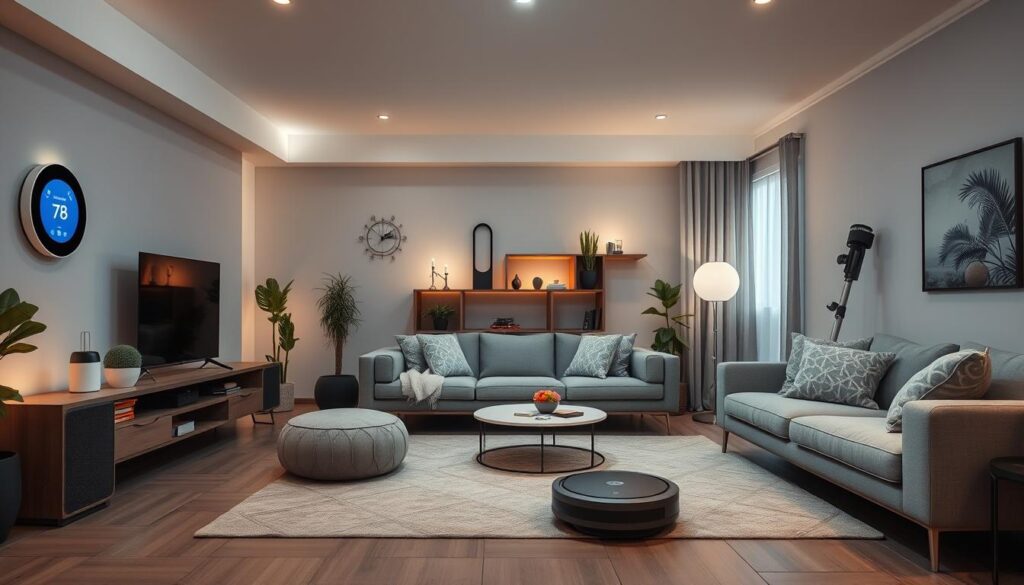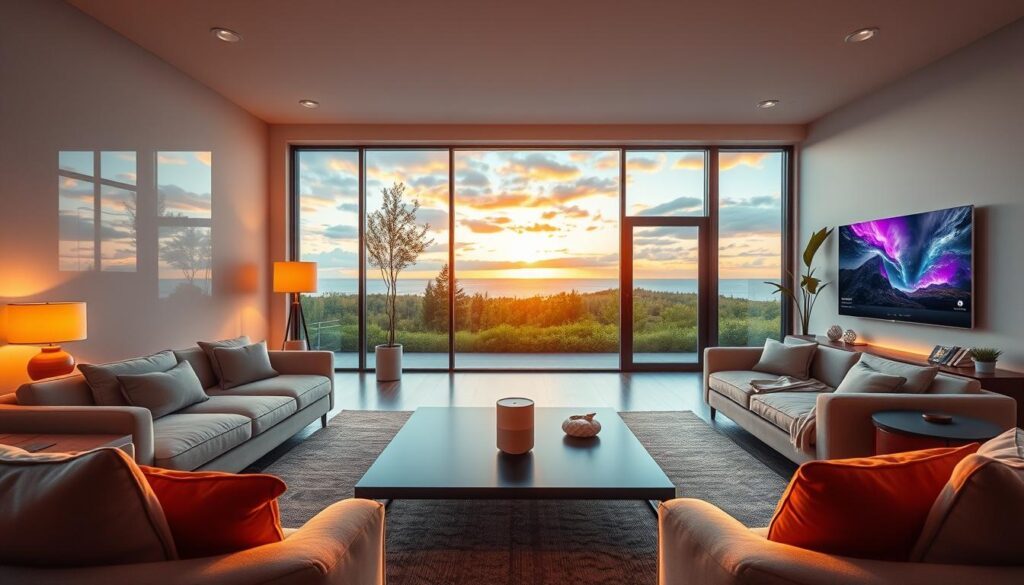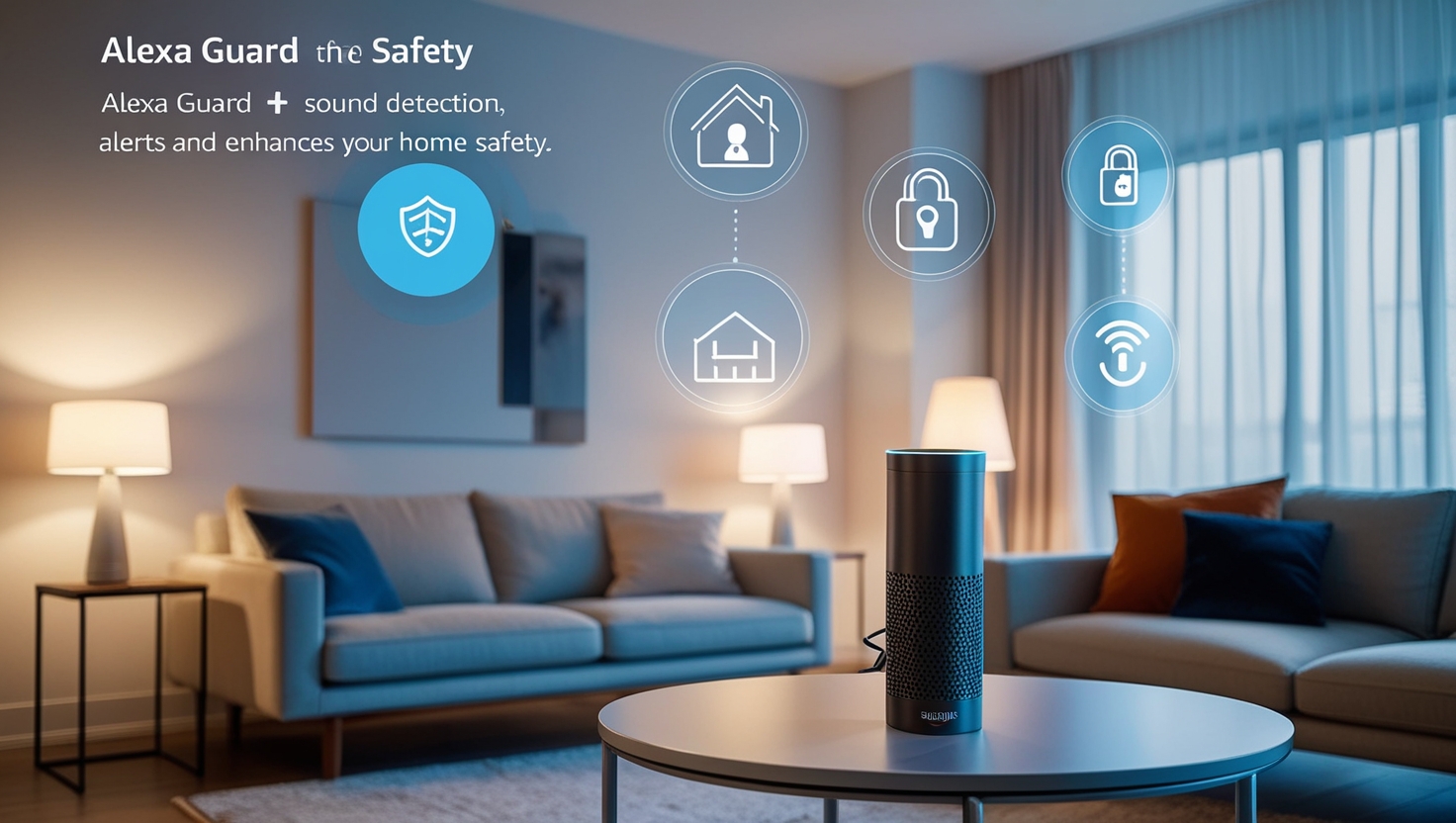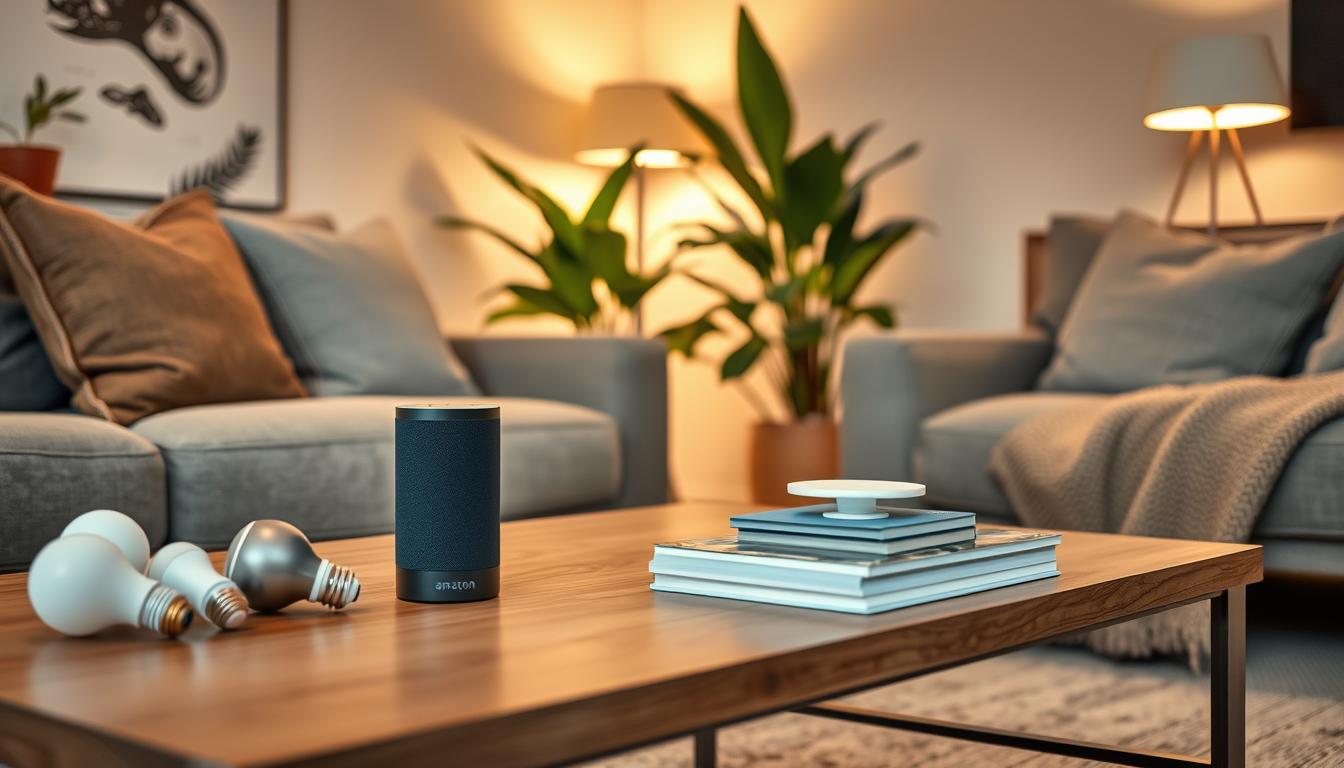Are we ready for a future where speaking changes our homes into personalized spaces? Voice-controlled smart home systems make this dream real, fitting into our lives smoothly. They let us control our homes easily with voice commands, starting a new era of smart home living.
This change makes our homes more than just places to live. It makes them safe, comfortable, and efficient. Smart home solutions are now key to creating homes that meet our needs.
We’re diving into how voice recognition tech makes our lives easier. It lets us enjoy living in a way that fits our likes. Let’s see how these changes affect our daily lives and change how we see home automation.
Key Takeaways
- Voice-controlled smart home systems redefine convenience and comfort in modern living.
- Intuitive voice commands streamline operations, making everyday tasks simpler.
- Integration with various smart devices enhances home efficiency and personalization.
- Smart home automation technology prioritizes user privacy and data protection.
- Regular updates ensure continuous enhancement and security of smart home systems.
- Personalized features allow customization, enhancing user engagement.
Understanding Voice-Controlled Smart Home Systems
Voice-controlled smart home systems are a new way to control our homes. We can use voice commands to manage devices, making our homes more efficient. These systems use advanced artificial intelligence to understand and act on our voice commands.
Platforms like Control4 and Josh.ai have made home automation easier. They offer simple interfaces for controlling devices. For example, Amazon’s Alexa lets us control lights with just our voice.
Looking to 2024, we’ll see better voice control systems. They will understand our language better and work with more devices. This will make our homes even more personalized.
People like controlling lights and thermostats the most. But they also want to control entertainment, security, and appliances with their voice. Manufacturers are making older devices work with new systems, so we don’t have to replace them.
Voice-controlled systems can be used in many areas, like healthcare and transportation. They use Bluetooth and Android to talk to devices. This lets us control many things at once.
As technology gets better, we’ll have more devices to choose from. This will make our homes even smarter and more fun.
The Benefits of Smart Home Automation
Smart home automation is changing how we live. About 77% of homeowners now use voice-controlled advantages. This makes life easier and better.
It lets us control things like lights and appliances with one device. We can also watch Netflix and Hulu easily. It’s all about making life simpler.
Smart homes also save money on electricity. For example, motorized blinds can keep out sunlight in summer. This lowers cooling costs. A system like Neo Smart Controller makes it easy and stylish to save energy.
Setting up a smart home can cost up to $15,000. But, you can start with devices under $100. This is a good way to begin improving your home.
Smart homes save money over time. As technology gets better, prices go down. More people are enjoying the perks of smart home automation. They feel safer and more comfortable.
| Feature | Benefit | Example |
|---|---|---|
| Voice Control | Enhanced convenience in daily tasks | Turning off lights with a voice command |
| Energy Efficiency | Reduction in electricity bills | Adjusting thermostat settings remotely |
| Automation | Time-saving in managing home devices | Scheduling lights to turn off automatically |
| Integration | Seamless control of multiple systems | Controlling entertainment systems and smart appliances |
Smart home technology is making our lives better. It improves comfort and security. It’s also a step towards a greener future.
How Voice Recognition Technology Improves Our Daily Lives
Voice recognition technology makes our lives easier with smart home interaction. Over a quarter of US adults have a smart speaker, as TechCrunch reports. By 2022, 55 percent of US adults will use smart speakers, making them a big part of our lives.
AI-powered systems change how we use household devices. We love giving commands to play music or adjust lights without touching anything. A big 72 percent of smart speaker owners use them every day, showing how much we rely on voice control.
People from all walks of life use voice recognition technology because it’s easy. It helps those who have trouble moving or are scared of tech. As we connect our homes more, we want voice assistants to handle security and other tasks. But, we also worry about privacy and security, which might stop some from using it.
The smart home market is set to grow to $138.9 billion by 2026. Voice recognition will play a big role in this growth. As AI gets better, voice systems will understand different accents better. This will make using smart home interaction even easier and more enjoyable for us.
Connected Home Devices: The Building Blocks of Smart Living
Connected home devices make our homes smarter, more comfortable, and secure. They change how we live every day. Let’s look at some key gadgets:
- Smart Speakers: Devices like the Amazon Echo let us control our homes with our voices. It’s super convenient.
- Smart Thermostats: The Ecobee Smart Thermostat Premium and Amazon Smart Thermostat save energy. They adjust the temperature just right for us.
- Smart Locks: The Ultraloq U-Bolt Pro has cool features like voice and fingerprint unlock. It makes our homes safer.
- Smart Cameras: The TP-Link Tapo C120 takes great pictures and tells us who’s there. It knows the difference between people, pets, and cars.
- Smart Lighting: The Roku Smart Bulb SE Color lets us pick from 16 million colors. It works with voice assistants without needing a hub.
- Smart Plugs: The TP-Link Kasa Smart Wi-Fi Plug Slim shows how much energy we use. It helps us save.
Connecting these devices is key to a smart home. They use protocols like Zigbee and Z-Wave. This makes them work well together.
More people want smart homes because they make life better. They solve problems like security and saving energy. With top brands, we can make our homes just right for us.

Voice-Controlled Smart Home Systems: Integrating with Virtual Assistant Devices
Using voice-controlled smart home systems with devices like Amazon Echo, Google Nest, and Apple HomePod changes how we live. These assistants let us control our homes with just our voice. This makes our homes work better for us.
For example, Amazon Alexa is a big hit in home automation. It shows how voice tech and virtual assistants are changing our homes. This is a big shift in how we use technology at home.
Features like scheduling and remote access make our smart homes better. We can control things like thermostats and lights with our voice. We can also set our homes to fit our personal needs.
We can summarize some key features and devices currently available in a table:
| Device Type | Functionality | Voice Assistant Compatibility |
|---|---|---|
| Smart Thermostats | Control heating and cooling remotely | Amazon Alexa, Google Assistant, Apple HomeKit |
| Smart Lights | Adjust brightness and color settings | Amazon Alexa, Google Assistant, Apple HomeKit |
| Smart Security Cameras | Live monitoring and recording | Amazon Alexa, Google Assistant |
| Smart Locks | Secure entry with customizable codes | Amazon Alexa, Google Assistant |
| Smart Smoke Detectors | Send alerts for potential hazards | Amazon Alexa, Google Assistant |
Technology is getting better, and voice-controlled devices will play a bigger role. Developers must keep making new solutions. This will help us enjoy our smart homes even more.
Enhancing Home Safety with Smart Home Voice Control
We all want to feel safe at home. Smart home voice control systems make our homes safer. They work with many security features.
About 61% of smart home users in the U.S. use voice commands. This shows how much we rely on voice tech for security.
Voice-activated systems let us control important home functions with just our voice. We can manage cameras, locks, and alarms with ease. Brands like Amazon and Google make these devices work better.
This tech is great for everyone, not just tech experts. It helps kids, seniors, and those who can’t move much. We can set up complex security plans with just one voice command.
Geofencing adds to our safety. It uses our phone’s location to turn on security features. Smart home systems are getting more popular, making our homes safer.
But, we need to watch out for cyber risks. Voice control needs a stable internet, which can be a problem. Still, smart home voice control makes our homes safer and easier to manage.

| Feature | Benefit |
|---|---|
| Voice Commands | Hands-free control of security features |
| Geofencing | Enhanced automation based on location |
| Compatibility | Works with various smart devices |
| Accessibility | Designed for all age groups |
| Security Automation | Triggers multiple actions with one command |
IoT Home Automation: Connecting Devices for Seamless Functionality
In our journey towards understanding IoT home automation, we see the power of connected devices. These connected devices make our homes work better together. They help us control things like temperature and lights.
Virtual assistants like Amazon’s Alexa, Google Assistant, and Apple’s Siri make it easy to use these devices. We can control our homes with just our voice. This shows what seamless smart living is all about.
Protocols like Zigbee and Z-Wave help devices from different brands work together. This means we can use devices from many brands, not just one. It makes our homes more flexible and diverse.
As we use this technology, keeping our homes safe is very important. With many connected devices, we need strong security to keep our privacy safe. Our safety and peace of mind depend on good security in these systems.
But, there are challenges with IoT home automation. We worry about privacy and keeping our data safe. Also, making sure all devices work together is a big task.
Fast internet is key for all this to work. It lets our devices, like thermostats and cameras, talk to each other smoothly. This makes our smart homes better.
The need for IoT in home automation is growing fast. Experts think the market will grow a lot in the next few years. Using IoT in our homes can make our lives better in many ways.
Creating a Personalized Home Environment with Smart Home Integration
Smart home devices are becoming more popular. They help us create a home that fits our lifestyle and tastes. Voice-activated assistants like Amazon Alexa and Google Assistant make it easy to control our homes. This lets us make our living spaces truly our own.
For example, smart lights like Philips Hue can change color and brightness. This lets us set up different lighting scenes for different times. Smart thermostats like Nest save energy and make our homes more comfortable.
Smart security features also add safety to our homes. Devices like Ring’s doorbell cameras and SimpliSafe systems keep us safe. They also make it easy to control our security with simple interfaces.
Kitchens are getting smarter too. Devices like Joule Sous Vide make cooking easier and more precise. This lets us cook meals that fit our taste preferences.
These technologies do more than just make life easier. They help us design our homes to fit our needs. As we adopt these changes, we get to enjoy the benefits of smart home integration.
| Device Type | Benefits | Examples |
|---|---|---|
| Smart Lighting | Energy efficiency and customizable settings | Philips Hue, Lutron |
| Smart Thermostats | Cost savings and energy usage insights | Nest, Ecobee |
| Smart Security | Enhanced safety and remote monitoring | Ring, SimpliSafe |
| Smart Kitchen Appliances | Improved cooking experiences and convenience | Joule Sous Vide, smart refrigerators |
The Role of Voice-Activated Home Devices in Modern Living
Voice-activated home devices have changed how we live today. They bring daily convenience that makes our lives better. These devices control things like entertainment, lights, and temperature easily.
They fit into our daily lives smoothly. This makes life simpler and more fun.
The tech behind these devices has grown a lot. Apple’s Siri came out in 2011, and Amazon’s Echo in 2014. Now, these devices understand us better and work with our homes in new ways.
Most homeowners, 74%, say the main good thing is how easy they are to use.
- They let us control our entertainment with just our voice.
- They help us keep track of our schedules and reminders.
- They make it easy to talk to family, even when we’re apart.
- They give us quick access to information and help for everyday tasks.
Real families show how these devices make life easier. For example, they can turn on lights and adjust the temperature when they get home. This makes coming home feel welcoming.
Also, 54% of people like how these devices make it easier to use smart home tech.
Looking ahead, voice tech will keep getting better. It will make our homes even more personal and smart. With 68% of homeowners wanting more personal touches in their homes, it’s clear we’re moving forward in a big way.
| Key Benefits of Voice-Activated Home Devices | Percentage of Homeowners Acknowledging Benefit |
|---|---|
| Convenience | 74% |
| Energy Efficiency | 62% |
| Enhanced Security | 89% |
| Accessibility | 54% |
Voice-activated home devices have changed our lives for the better. They mix tech with our daily routines for a smarter way of living.
Future Trends in Voice-Controlled Smart Home Systems
Looking ahead, voice-controlled smart homes are set for big changes. New tech like better artificial intelligence will lead the way. This will make our homes more smart and easy to use.
Voice tech has grown a lot since the 1990s. Back then, it was just starting to get better. By the 2000s, we had systems like X10 that let us control things with our voice. The 2010s brought even more with Amazon Alexa and Google Home.
New tech like voice biometrics will soon be part of our homes. It lets systems know who’s talking and act accordingly. This makes our homes more personal. Also, linking these systems with the Internet of Things (IoT) will make our homes even smarter.
Experts think the smart home market will grow a lot. It’s expected to hit $385 billion by 2036. In 2023, it was already at $85 billion. The tech behind voice systems, like Natural Language Processing, will play a big role in this growth.
| Year | Smart Home Market Size | CAGR | NLP Segment Share | Cloud Deployment Share | North America Share | Asia Pacific Share |
|---|---|---|---|---|---|---|
| 2023 | $85 billion | N/A | N/A | N/A | 31% | 23% |
| 2036 | $385 billion | 28% | 43% | 60% | 31% | 23% |
The future of smart homes looks bright. With better tech, our homes will be more convenient and safe. This change will make our lives easier and more enjoyable.
Conclusion
We’ve looked at how voice-controlled smart home systems change our lives. They make our homes safer and more convenient. Voice assistants like Google Assistant are very accurate, making our homes easy to manage.
The future of smart homes looks bright. With Amazon Alexa and Josh.ai, we can make our homes just right for us. We can set up our own routines and commands, making our homes more accessible.
Investing in smart home tech, like Nest thermostats, saves us money on energy. These systems offer many benefits now and will make our homes better in the future. They help us live in a more comfortable, safe, and energy-saving way.






